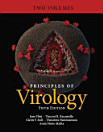Principles of Virology: Edition 5
ഈ ഇ-ബുക്കിനെക്കുറിച്ച്
This fifth edition was updated to keep pace with the ever-changing field of virology. In addition to the beloved full-color illustrations, video interviews with leading scientists, movies, and links to exciting blogposts on relevant topics, this edition includes study questions and active learning puzzles in each chapter, as well as short descriptions regarding the key messages of references of special interest.
Volume I: Molecular Biology focuses on the molecular processes of viral reproduction, from entry through release. Volume II: Pathogenesis and Control addresses the interplay between viruses and their host organisms, on both the micro- and macroscale, including chapters on public health, the immune response, vaccines and other antiviral strategies, viral evolution, and a brand new chapter on the therapeutic uses of viruses. These two volumes can be used for separate courses or together in a single course. Each includes a unique appendix, glossary, and links to internet resources.
Principles of Virology, Fifth Edition, is ideal for teaching the strategies by which all viruses reproduce, spread within a host, and are maintained within populations. This edition carefully reflects the results of extensive vetting and feedback received from course instructors and students, making this renowned textbook even more appropriate for undergraduate and graduate courses in virology, microbiology, and infectious diseases.
റേറ്റിംഗുകളും റിവ്യൂകളും
രചയിതാവിനെ കുറിച്ച്
Jane Flint is Professor Emerita of Molecular Biology at Princeton University. Dr. Flint’s research focused on investigation of the mechanisms by which viral gene products modulate host pathways and antiviral defenses to allow efficient reproduction in normal human cells of adenoviruses, viruses that are used in such therapeutic applications as gene transfer and cancer treatment.
Vincent R. Racaniello is Higgins Professor of Microbiology & Immunology at Columbia University Vagelos College of Physicians & Surgeons. Dr. Racaniello has been studying viruses for over 40 years, including polio- virus, rhinovirus, enteroviruses, hepatitis C virus, and Zika virus. He blogs about virus-es at virology.ws and is host of This Week in Virology.
Glenn F. Rall is a Professor and the Chief Academic Officer at the Fox Chase Cancer Center, and is an Adjunct Professor in the Microbiology and Immunology departments at the University of Pennsylvania, as well as Thomas Jefferson, Drexel, and Temple Universities. Dr. Rall studies viral infections of the brain and the immune responses to those infections, with the goal of defining how viruses contribute to disease.
Theodora Hatziioannou is a Research Associate Professor at Rockefeller University and is actively involved in teaching programs at Albert Einstein College of Medicine. Dr. Hatziioannou has worked on multiple viruses with a focus on retroviruses and the molecular mechanisms that govern virus tropism and on the improvement of animal models for human disease.
Anna Marie Skalka is a Professor Emerita and former Senior Vice President for Basic Research at the Fox Chase Cancer Center. Dr. Skalka is internationally recognized for her contributions to the understanding of the biochemical mechanisms by which retroviruses replicate and insert their genetic material into the host genome, as well as her research into other molecular aspects of retrovirus biology.







